Abstract
Alzheimer’s disease (AD) is a complex neurological disorder and no effective drug is available for its treatment. Numerous pathological conditions are believed to be responsible for the initiation and development of AD including c-Jun N-terminal kinases (JNKs). The JNKs are one of the enzymes from the mitogen-activated protein kinase (MAPK) family that controls the phosphorylation of various transcription factors on serine and threonine residues, and hold significant responsibilities in tasks like gene expression, cell proliferation, differentiation, and apoptosis. Since, JNK3 is primarily expressed in the brain hence its increased levels in the brain are associated with the AD pathology promoting neurofibrillary tangles, senile plaques, neuroinflammation, and nerve cell apoptosis. The current research work is focused on the development of novel JNK inhibitors as therapeutics for AD employing a structure-based virtual screening (SBVS) approach. The ZINC database (14634052 compounds) was investigated after employing pan assay interference (PAINs), drug-likeness, and diversity picking filter to distinguish molecules interacting with JNK3 by following three docking precision criteria: High Throughput Virtual Screening (HTVS), Standard Precision (SP), and Extra Precision (XP) & MMGBSA. Five lead molecules showed a better docking score in the range of -13.091 to -14.051 kcal/mol better than the reference compound (− 11.828 kcal/mol). The lead compounds displayed acceptable pharmacokinetic properties and were subjected to molecular dynamic simulations of 100 ns and binding free energy calculations. All the lead molecules showed stable RMSD and hydrogen bond interactions throughout the trajectory. The ∆GMM/PBSA_total score for the lead compounds ZINC220382956, ZINC147071339, ZINC207081127, ZINC205151456, ZINC1228819126, and CC-930 was calculated and found to be − 31.39, − 42.8, − 37.04, − 39.01, − 36.5, − 34.16 kcal/mol, respectively. Thus, it was concluded that the lead molecules identified in these studies have the potential to be explored as potent JNK3 inhibitors.














Similar content being viewed by others
Data availability
The datasets employed for conducting the computational study are readily accessible and available for utilization at https://doi.org/https://doi.org/10.5281/zenodo.8278365.
References
Lisnock J, Griffin P, Calaycay J, Frantz B, Parsons J, O’Keefe SJ, LoGrasso P (2000) Activation of JNK3 alpha 1 requires both MKK4 and MKK7: kinetic characterization of in vitro phosphorylated JNK3 alpha 1. Biochemistry 39(11):3141–3148
Wada T, Penninger JM (2004) Stress kinase MKK7: saviour of cell cycle arrest and cellular senescence. Cell Cycle 3(5):575–577
Fleming Y, Armstrong CG, Morrice N, Paterson A, Goedert M, Cohen P (2000) Synergistic activation of stress-activated protein kinase 1/c-Jun N-terminal kinase (SAPK1/JNK) isoforms by mitogen-activated protein kinase kinase 4 (MKK4) and MKK7. Biochem J 352:145–154
Kant S, Craige SM, Chen K, Reif MM, Learnard H, Kelly M, Caliz AD, Tran K-V, Ramo K, Peters OM, Freeman M, Davis RJ, Keaney JF (2019) Neural JNK3 regulates blood flow recovery after hindlimb ischemia in mice via an Egr1/Creb1 axis. Nat Commun 10(1):4223
Yarza R, Vela S, Solas M, Ramirez MJ (2016) c-Jun N-terminal kinase (JNK) signaling as a therapeutic target for Alzheimer’s disease. Front Pharmacol 6:321
Zheng K, Park CM, Iqbal S, Hernandez P, Park H, LoGrasso PV, Feng Y (2015) Pyridopyrimidinone derivatives as potent and selective c-Jun N-terminal kinase (JNK) inhibitors. ACS Med Chem Lett 6(4):413–418
Musi CA, Agrò G, Santarella F, Iervasi E, Borsello T (2020) JNK3 as therapeutic target and biomarker in neurodegenerative and neurodevelopmental brain diseases. Cells 9(10):2190
Guo C, Whitmarsh AJ (2008) The β-arrestin-2 scaffold protein promotes c-Jun N-terminal kinase-3 activation by binding to its nonconserved N terminus. J Biol Chem 283(23):15903–15911
Yoshida H, Hastie CJ, McLauchlan H, Cohen P, Goedert M (2004) Phosphorylation of microtubule-associated protein tau by isoforms of c-Jun N-terminal kinase (JNK). J Neurochem 90(2):352–358
Wang M, Hayashi H, Horinokita I, Asada M, Iwatani Y, Liu J-X, Takagi N (2021) Neuroprotective effects of Senkyunolide I against glutamate-induced cells death by attenuating JNK/caspase-3 activation and apoptosis. Biomed Pharmacother 140:111696
Yoon SO, Park DJ, Ryu JC, Ozer HG, Tep C, Shin YJ, Lim TH, Pastorino L, Kunwar AJ, Walton JC, Nagahara AH (2012) JNK3 perpetuates metabolic stress induced by Aβ peptides. Neuron 75(5):824–837
Kuan CY, Whitmarsh AJ, Yang DD, Liao G, Schloemer AJ, Dong C, Bao J, Banasiak KJ, Haddad GG, Flavell RA, Davis RJ, Rakic P (2003) A critical role of neural-specific JNK3 for ischemic apoptosis. Proc Natl Acad Sci USA 100(25):15184–15189
de Lemos L, Junyent F, Camins A, Castro-Torres RD, Folch J, Olloquequi J, Beas-Zarate C, Verdaguer E, Auladell C (2018) Neuroprotective effects of the absence of JNK1 or JNK3 isoforms on kainic acid-induced temporal lobe epilepsy-like symptoms. Mol Neurobiol 55(5):4437–4452
Sevilla A, Santos CR, Barcia R, Vega FM, Lazo PA (2004) c-Jun phosphorylation by the human vaccinia-related kinase 1 (VRK1) and its cooperation with the N-terminal kinase of c-Jun (JNK). Oncogene 23(55):8950–8958
Cory S, Adams JM (2002) The Bcl2 family: regulators of the cellular life-or-death switch. Nat Rev Cancer 2(9):647–656
Qin P, Ran Y, Liu Y, Wei C, Luan X, Niu H, Peng J, Sun J, Wu J (2022) Recent advances of small molecule JNK3 inhibitors for Alzheimer’s disease. Bioorg Chem 128:106090
Godieva V, Sammoura F, Paz SV, Han Y, Guida VD, Rishel MJ, Richardson JR, Chambers JW (2024) Physiological JNK3 Concentrations Are Higher in Motor-related and Disease-implicated Brain Regions of C57BL6/J Mice. bioRxiv
Rajan RK, Ramanathan M (2020) Identification and neuroprotective evaluation of a potential c-Jun N-terminal kinase 3 inhibitor through structure-based virtual screening and in-vitro assay. J Comput Aided Mol Des 34(6):671–682
Krenitsky VP, Nadolny L, Delgado M, Ayala L, Clareen SS, Hilgraf R, Albers R, Hegde S, D’Sidocky N, Sapienza J, Wright J (2012) Discovery of CC-930, an orally active anti-fibrotic JNK inhibitor. Bioorg Med Chem Lett 22(3):1433–1438
Wu Q, Wu W, Jacevic V, Franca TC, Wang X, Kuca K (2020) Selective inhibitors for JNK signalling: a potential targeted therapy in cancer. J Enzyme Inhibit Med Chem 35(1):574–583
Rajan RK, Kumar RP, Ramanathan M (2024) Piceatannol improved cerebral blood flow and attenuated JNK3 and mitochondrial apoptotic pathway in a global ischemic model to produce neuroprotection. Naunyn Schmiedebergs Arch Pharmacol 397(1):479–496
Kumar B, Dwivedi AR, Arora T, Raj K, Prashar V, Kumar V, Singh S, Prakash J, Kumar V (2022) Design, Synthesis, and pharmacological evaluation of N-propargylated diphenylpyrimidines as multitarget directed ligands for the treatment of Alzheimer’s Disease. ACS Chem Neurosci 13(14):2122–2139
Kumar B, Dwivedi AR, Sarkar B, Gupta SK, Krishnamurthy S, Mantha AK, Parkash J, Kumar V (2019) 4,6-Diphenylpyrimidine derivatives as dual inhibitors of monoamine oxidase and acetylcholinesterase for the treatment of Alzheimer’s disease. ACS Chem Neurosci 10(1):252–265
Kumar B, Kumar M, Dwivedi AR, Kumar V (2018) Synthesis, biological evaluation and molecular modeling studies of propargyl-containing 2, 4, 6-Trisubstituted pyrimidine derivatives as potential anti-Parkinson agents. ChemMedChem 13(7):705–712
Kumar B, Kumar V, Prashar V, Saini S, Dwivedi AR, Bajaj B, Mehta D, Parkash J, Kumar V (2019) Dipropargyl substituted diphenylpyrimidines as dual inhibitors of monoamine oxidase and acetylcholinesterase. Eur J Med Chem 177:221–234
Kumar B, Prakash Gupta V, Kumar V (2017) A perspective on monoamine oxidase enzyme as drug target: challenges and opportunities. Curr Drug Targets 18(1):87–97
Swahn B-M, Huerta F, Kallin E, Malmström J, Weigelt T, Viklund J, Womack P, Xue Y, Öhberg L (2005) Design and synthesis of 6-anilinoindazoles as selective inhibitors of c-Jun N-terminal kinase-3. Bioorg Med Chem Lett 15(22):5095–5099
Wizard, P. P.; Epik, S.; Prime, L.; Glide, S. J. N. Y., NY, LLC. 2021, 34.
Shelley JC, Cholleti A, Frye LL, Greenwood JR, Timlin MR, Uchimaya M (2007) Epik: a software program for pK a prediction and protonation state generation for drug-like molecules. J Comput-Aided Mol Des 21:681–691
Lu C, Wu C, Ghoreishi D, Chen W, Wang L, Damm W, Ross GA, Dahlgren MK, Russell E, Von Bargen CD, Abel R (2021) OPLS4: Improving force field accuracy on challenging regimes of chemical space. J Chem Theory Comput 17(7):4291–4300
Repasky MP, Shelley M, Friesner RA (2007) Flexible ligand docking with Glide. Curr Protoc Bioinform 18(1):8–12
Baell JB, Nissink JWM (2018) Seven year itch: Pan-assay interference compounds (PAINS) in 2017 utility and limitations. ACS Chem Biol 13(1):36–44
Landrum G (2013) RDKit: a software suite for cheminformatics, computational chemistry, and predictive modeling. Greg Landrum 8:31
Berthold MR, Cebron N, Dill F, Gabriel TR, Kötter T, Meinl T, Ohl P, Thiel K, Wiswedel B (2009) KNIME-the Konstanz information miner: version 2.0 and beyond. AcM SIGKDD Explor Newslett 11(1):26–31
Hevener KE, Zhao W, Ball DM, Babaoglu K, Qi J, White SW, Lee RE (2009) Validation of molecular docking programs for virtual screening against dihydropteroate synthase. J Chem Inform Model 49(2):444–460
Kirchmair J, Markt P, Distinto S, Wolber G, Langer T (2008) Evaluation of the performance of 3D virtual screening protocols: RMSD comparisons, enrichment assessments, and decoy selection—what can we learn from earlier mistakes? J Comput-Aided Mol Des 22:213–228
Mysinger MM, Carchia M, Irwin JJ, Shoichet BK (2012) Directory of useful decoys, enhanced (DUD-E): better ligands and decoys for better benchmarking. J Med Chem 55(14):6582–6594
Gaulton A, Hersey A, Nowotka M, Bento AP, Chambers J, Mendez D, Mutowo P, Atkinson F, Bellis LJ, Cibrián-Uhalte EJN (2017) The ChEMBL database in 2017. 45 (D1), D945-D954.
Biharee A, Yadav A, Jangid K, Singh Y, Kulkarni S, Sawant DM, Kumar P, Thareja S, Jain AK (2023) Flavonoids as promising anticancer agents: an in silico investigation of ADMET, binding affinity by molecular docking and molecular dynamics simulations. J Biomol Struct Dyn 41(16):7835–7846
Dighe SN, Deora GS, De la Mora E, Nachon F, Chan S, Parat MO, Brazzolotto X, Ross BP (2016) Discovery and structure–activity relationships of a highly selective butyrylcholinesterase inhibitor by structure-based virtual screening. J Med Chem 59(16):7683–7689
Release SJS (2019) LLC, New York, 4: LigPrep.
Kuhn B, Kollman PA, Stahl M (2004) Prediction of pKa shifts in proteins using a combination of molecular mechanical and continuum solvent calculations. J Comput Chem 25(15):1865–1872
Lu C, Wu C, Ghoreishi D, Chen W, Wang L, Damm W, Ross GA, Dahlgren MK, Russell E, Von Bargen CD (2021) OPLS4: improving force field accuracy on challenging regimes of chemical space. J Chem Theory Comput 17(7):4291–4300
QikProp S (2019) LLC. New York
Jangid K, Devi B, Sahoo A, Kumar V, Dwivedi AR, Thareja S, Kumar R, Kumar V (2024) Virtual screening and molecular dynamics simulation approach for the identification of potential multi-target directed ligands for the treatment of Alzheimer’s disease. J Biomol Struct Dyn 42(1):509–527
Devi B, Vasishta SS, Das B, Baidya AT, Rampa RS, Mahapatra MK, Kumar R (2023) Integrated use of ligand and structure-based virtual screening, molecular dynamics, free energy calculation and ADME prediction for the identification of potential PTP1B inhibitors. Mol Diversity. https://doi.org/10.1007/s11030-023-10608-8
Das A, Sarangi M, Jangid K, Kumar V, Kumar A, Singh PP, Kaur K, Kumar V, Chakraborty S, Jaitak V (2023) Identification of 1, 3, 4-oxadiazoles as tubulin-targeted anticancer agents: a combined field-based 3D-QSAR, pharmacophore model-based virtual screening, molecular docking, molecular dynamics simulation, and density functional theory calculation approach. J Biomol Struct Dyn. https://doi.org/10.1080/07391102.2023.2256876
Valdés-Tresanco MS, Valdés-Tresanco ME, Valiente PA, Moreno E (2021) gmx_MMPBSA: a new tool to perform end-state free energy calculations with GROMACS. J Chem Theory Comput 17(10):6281–6291
Landrum, G., Rdkit: Open-source cheminformatics software. 2016.
Shivanika C, Kumar D, Ragunathan V, Tiwari P, Sumitha A (2020) Molecular docking, validation, dynamics simulations, and pharmacokinetic prediction of natural compounds against the SARS-CoV-2 main-protease. J Biomol Struct Dyn. https://doi.org/10.1080/07391102.2020.1815584
Koch P (2021) Inhibitors of c-Jun N-Terminal Kinase 3. In: Laufer S (ed) Proteinkinase Inhibitors. Springer International Publishing, Cham, pp 203–224
Messoussi A, Feneyrolles C, Bros A, Deroide A, Daydé-Cazals B, Chevé G, Van Hijfte N, Fauvel B, Bougrin K, Yasri A (2014) Recent Progress in the Design, Study, and Development of c-Jun N-Terminal Kinase Inhibitors as Anticancer Agents. Chem Biol 21(11):1433–1443
Mishra P, Günther S (2018) New insights into the structural dynamics of the kinase JNK3. Sci Rep 8(1):9435
Xie, X.; Gu, Y.; Fox, T.; Coll, J. T.; Fleming, M. A.; Markland, W.; Caron, P. R.; Wilson, K. P.; Su, M. S., Crystal structure of JNK3: a kinase implicated in neuronal apoptosis. Structure (London, England : 1993) 1998, 6 (8), 983–91.
Release, S., 4: LigPrep. Schrödinger, LLC, New York, NY 2019.
Maestro, S., Maestro. Schrödinger, LLC, New York, NY 2020, 2020.
Zhang X, Perez-Sanchez H, Lightstone FC (2017) A comprehensive docking and MM/GBSA rescoring study of ligand recognition upon binding antithrombin. Curr Top Med Chem 17(14):1631–1639
Ferreira LL, Andricopulo AD (2019) ADMET modeling approaches in drug discovery. Drug Discov Today 24(5):1157–1165
Nema S, Chaturvedi R, Verma K, Anvikar AR, Tiwari A, Bharti PK (2023) 2024 A computational strategy for systematic virtual screening of plasmodium falciparum heme detoxification protein inhibitors from the Drugbank database. J Biomol Struct Dyn. https://doi.org/10.1080/07391102.2301510
Rabaan AA, Almansour ZH, Al Bshabshe A, Halwani MA, Al-Subaie MF, Al Kaabi NA, Alshamrani SA, Alshehri AA, Nahari MH, Alqahtani AS (2024) 2024 Application of temperature-dependent and steered molecular dynamics simulation to screen anti-dengue compounds against Marburg virus. J Biomol Struct Dyn. https://doi.org/10.1080/07391102.2303386
Rajendrasozhan S, Ahmad I, Obaidur Rab S, Alshahrani MY, Abdullah Almuqri E, Ahmad Siddiqui J, Mushtaque M (2024) In-silico investigation of RPS6KB1 associated cancer inhibitor: a drug repurposing study. J Biomol Struct Dyn. https://doi.org/10.1080/07391102.2024.2304679
Biharee A, Singh Y, Kulkarni S, Jangid K, Kumar V, Jain AK, Thareja S (2024) An amalgamated molecular dynamic and Gaussian based 3D-QSAR study for the design of 2, 4-thiazolidinediones as potential PTP1B inhibitors. J Mol Graph Model 127:108695
da Silva FB, Simien JM, Viegas RG, Haglund E, Leite VBP (2024) Exploring the folding landscape of leptin: Insights into threading pathways. J Struct Biol 216(1):108054
Acknowledgements
KJ would like to acknowledge the Indian Council of Medical Research (ICMR), New Delhi, India for awarding a Senior Research Fellowship (File No. 45/29/2022-BIO/BMS). VK is thankful to CSIR New Delhi for providing grant reference number 02/(0354)/19/EMRII and also to DST-STARS (SR/FST/CS-I/2020/154). Authors are gratefully acknowledged for the access to the ‘PARAM Smriti Facility’ under the National Supercomputing Mission, Government of India at NABI, Mohali. NK and Vinay Kumar are grateful to UGC and CSIR, respectively for providing a Senior Research Fellowship.
Funding
Indian Council of Medical Research, 45/29/2022-BIO/BMS,Council of Scientific and Industrial Research,India,02/(0354)/19/EMRII,MoE STARS,IISc Bangolre,STARS2/2023-0040
Author information
Authors and Affiliations
Contributions
VK: has designed and instructed the study and is involved in manuscript preparation. BD and KJ: have performed computational work, analyzed the results, and prepared a draft of the manuscript with equal contribution. NK and VK: have performed ADME, MM/PBSA, and helped in editing and finalizing the manuscript.
Corresponding author
Ethics declarations
Competing interests
The authors declare no competing interests.
Conflict of interest
The authors claim no competing financial interest.
Additional information
Publisher's Note
Springer Nature remains neutral with regard to jurisdictional claims in published maps and institutional affiliations.
Supplementary Information
Below is the link to the electronic supplementary material.
Rights and permissions
Springer Nature or its licensor (e.g. a society or other partner) holds exclusive rights to this article under a publishing agreement with the author(s) or other rightsholder(s); author self-archiving of the accepted manuscript version of this article is solely governed by the terms of such publishing agreement and applicable law.
About this article
Cite this article
Devi, B., Jangid, K., Kumar, N. et al. Identification of potential JNK3 inhibitors through virtual screening, molecular docking and molecular dynamics simulation as therapeutics for Alzheimer’s disease. Mol Divers (2024). https://doi.org/10.1007/s11030-024-10820-0
Received:
Accepted:
Published:
DOI: https://doi.org/10.1007/s11030-024-10820-0




